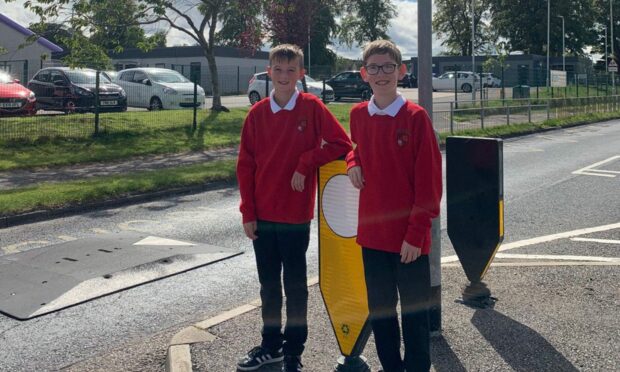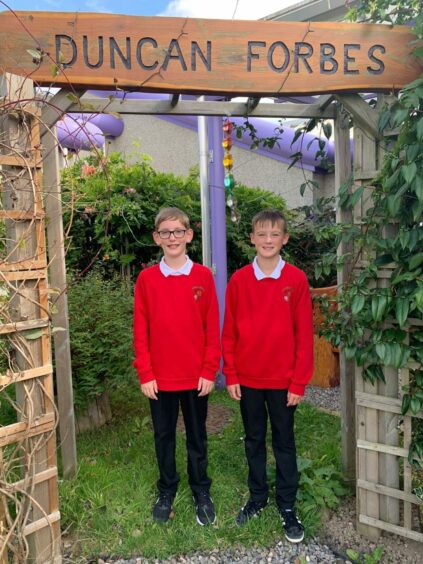Duncan Forbes Primary School is about to become the first in Highland to trial a scheme that bans cars from school streets.
The School Streets project works by drastically reducing – or completely removing – motorised vehicles at school drop-off and pick-up times.
The initiative has already enjoyed success in Moray and the central belt, but yesterday Highland Council gave the green light to its own pilots.
Four Highland schools will trial School Streets, with Duncan Forbes in Culloden going first.
And it’s safe to say, they can’t wait to get going.
How will it work?
After the October holidays, flashing signs will go up advising drivers that they can’t access the school grounds at starting and finishing times.
People who are driving to school will be asked to park in the school’s designated drop-off zone or a new ‘park and stride’ facility at Culloden House.
From there, pupils can safely walk to school.
Nearby residents will be given a permit, and the school will still allow emergency services and utility companies access.
Apart from that, everyone is encouraged to walk, cycle or scoot to school.
Fast speeds and near misses
Duncan Forbes hopes the School Streets project will help to improve road safety for the whole school community.
Headteacher Wendy Mackay says speeding is a big problem.
“For a number of years this has been a constant discussion point at parent council meetings,” she says. “We have Barn Church Road, which is a 40mph road, above our school.
“Then Kessock Road, which comes around the front of our school, is often used as a faster route or a way to avoid traffic lights.
“Quite often we have traffic going far too fast on Kessock Road, which is the main place where the children cross.
“Our school roll has increased exponentially and we simply can’t ignore the fact that the children need a safe way to get to school.”
Radical action
One of the aims of School Streets is to encourage active travel. Mrs Mackay says that’s a big interest at Duncan Forbes, describing her pupils as “really active”.
“The vast majority of our pupils already walk, scoot or cycle to the school,” she says. “Only a small number of people drive and generally only if they really need to.”
Duncan Forbes supports these active choices with ‘bikeability’ training and has worked with the council on a range of traffic calming measures. The school also runs Living Streets’ WOW Travel Tracker project, which logs daily journeys and rewards walking or wheeling to school.
However, Mrs Mackay and the parent council wanted to do more.
“We really wanted to do something radical to make the point,” says Mrs Mackay. “Our parents are completely on board. Residents around the school are also hugely supportive as they’ve had problems with people parking at their homes.”
The school isn’t at all concerned that some might complain about the radical plan. In fact, Mrs Mackay says it can’t come quickly enough.
“We consulted our community all the way through,” she says. “If anything, we wanted it last year. We came back from the holidays and lots of people actually thought the scheme was already running. There were no cars!”
This, she says, is a good sign.
‘We will be much safer’
If the adults had any doubts, it’s clear that the pupils would set them right.
Mrs Mackay already has a rota system of Primary 7 pupils who are lining up to help with enforcement. The senior pupils will support younger children with crossing the road around school.
Asked if they are keen, they cheer “Yeah!” from behind their headteacher.
“I think School Streets is a really good idea,” says Alastair Grant in P7. “Our school values are ‘achieving, happy and safe’. We will be much safer.”
Alastair witnessed a car accident near his house on Barn Church Road the day before, while he was walking his dog with his mum. He cycles to school and says he will feel more confident when there are fewer cars.
His friend Toby Watkins lives too far away to walk but says he sees “lots of cars being dangerous”.
Mrs Mackay says she’s really proud of her pupils and the whole school community for supporting the project.
“I think it’s really good we’re going to be first,” says Toby. “We’re the best school, so I’m not surprised.”
More from the Schools & Family team
Parents vow to ramp up pressure after Aberdeen school build delayed


Conversation